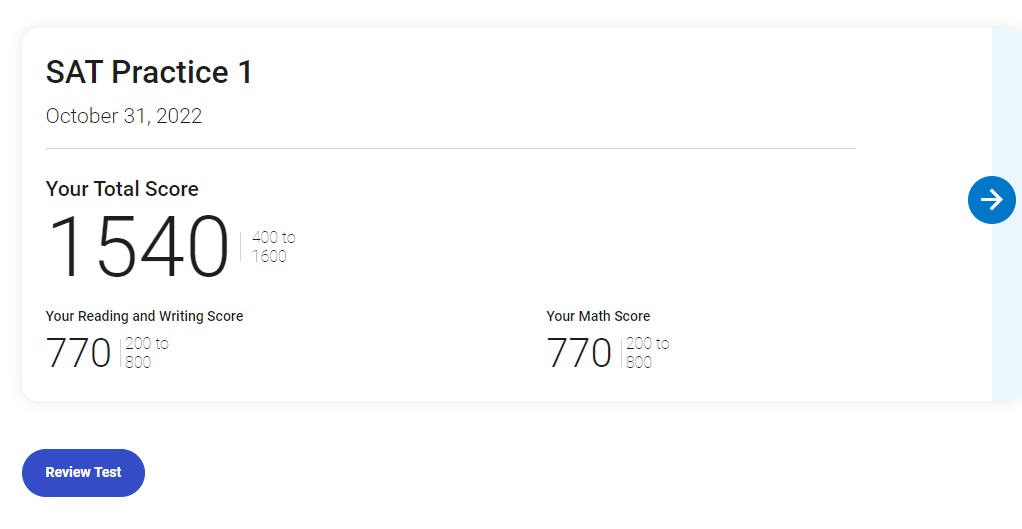Scoring 750+ in SAT Math

Get a high score in Math, and improve your chances of getting into your dream university!
For international students applying to top US colleges, a score of 1500+ is a prerequisite. This means you need to score well in both the sections of the SAT test, English and Math. This article looks at some ways you can build up on your Math score in the new, digital SAT.
The Digital SAT Math test has two sections of 22 questions each. These questions test you on a wide range of subjects, ranging from Arithmetic, Algebra, Geometry, Trigonometry etc. The new digital format is also an adaptive test – meaning questions get tougher or easier, depending on how you are doing. Since you are aiming for a high score, the questions will get more difficult. However, the concepts and the subjects that you get tested on are still the same.
Step 1: Assess where you stand
Start working on your test prep – Math practice tests and full length mock tests. While the new SAT will be digital, old paper style math tests are still useful – they offer a large bank of questions to test your and hone your skill level. Similarly, other materials such as books on SAT math (like Barron’s) are a good source of questions for practice. You can also attempt the Math section of the current paper based SAT tests.
If you are attempting questions from an exercise book, timing yourself will be helpful. These exercises are usually questions of mixed difficulty, so you should aim to solve these at the rate of 1 minute per question or less.
However, even if you run out of time, don’t stop the test – answer all questions. You can work on improving your speed later on – at this stage, it is also important to find out where you stand and your knowledge of the various topics.
Step 2: Analyze the Mistakes
Once you have completed the test, score yourself.
If you are aiming for a score of 750+, you should have a firm grasp of the key concepts across various topics. This means there are no questions which you have left unattempted because you couldn’t understand those.
Since you took extra time to address all questions, any unattempted questions are those you didn’t understand. These topics represent the gaps in your understanding. Get back to your text books to read up on these concepts and practice more. It is likely that topics such as Parabola, Functions and Complex Numbers may have questions that you are not entirely comfortable with.
From the questions you got wrong, understand how you made the mistake. Test setters design a few questions with traps, which are not immediately evident. The quantity being asked for is not the quantity that you first get, but has to be derived from it. In some word problems, a straightforward equation has to be interpreted – but a complex sounding explanation is provided to confuse the test taker. Read questions carefully – if it helps, scribble on the paper the quantity that you have to find.
Step 3: Practice More
This applies for the entire curriculum – the sections which you understand, as well as those that you couldn’t answer. As you practice more, you get more efficient at answering these questions. In many Math problems, as you solve more and more problems, at some point, the subject just ‘clicks’ for you. In many cases, you start developing your own short cuts for some problems.
In case of Trigonometry and Geometry, it is important that you remember the common ratios and formulae, even though these are provided alongside. Everytime you have to refer to the sheet, you add a step, and there is a chance of an error. If you have to look up a formula/ratio, it also means you haven’t practised those questions enough.
Practice these questions with stopwatch running alongside and time yourself. Apart from accuracy, you also want to work on speed.
Some Other Tips
The Digital SAT provides an inbuilt calculator. Use that calculator and become familiar with its use. The test day is a bad time to start learning the use of a new tool.
Be very familiar with multiplication tables of numbers up to 20. This will enable you to do a lot of calculations mentally, and will help improve your speed in solving problems. Similarly, you should know the squares of numbers up to 25 or 30. You don’t get quizzed on these, but it saves time if you can do these calculations faster.
A good SAT score is a crucial part of your application to top US universities. With consistent practice over three to five months, students see significant improvements. We encourage you to work hard on your SAT prep to create a compelling application for admission to your dream university.
About the Author:

Amit Bhandari holds a B-Tech from the Indian Institute of Technology, BHU and a MBA from the Indian Institute of Management, Ahmedabad.
He is a published author, an entrepreneur and a business professional with experience of building new teams and brands. His book titled “India and the Changing Geopolitics of Oil” was published in late 2021. He is the founder of tezbid.com, an online platform specializing in antique coins.
Amit started his career with the Economic Times, where the tracked the energy sector. He was a part of the start-up team of ET Now, the business news channel. Amit was responsible for setting up India Reality Research, a new research outfit within CLSA India, a stockbroking firm. He is a Senior Fellow with Gateway House: Indian Council on Global Affairs, a Mumbai based think tank. His work in public policy has been cited extensively in Indian and world media over the past several years.
Scholarly helps ambitious international students locate the right universities and courses to pursue their education. We provide college credit courses and research papers to students that want to learn more and differentiate themselves. We help students develop and present their best version to their dream university. Our recommendations are based on the student’s field of interest, academic performance, financial resources and career plans. We provide test preparation classes from the best teachers to help improve scores and thus the prospects for admission. We also assist students with their visa and loan applications to reduce the anxiety associated with international education.
For additional questions about international education, choice of majors, university selection or admission strategies please visit the Questions section of our website.

 Previous Post
Previous Post
